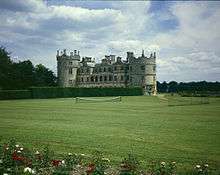John Thorpe
John Thorpe or Thorp (c.1565–1655?; fl.1570–1618) was an English architect.
Life
Little is known of his life, and his work is dubiously inferred, rather than accurately known, from a folio of drawings in the Sir John Soane's Museum,[1] to which Horace Walpole called attention, in 1780, in his Anecdotes of Painting; but how far these were his own is uncertain.
He was engaged on a number of important English houses of his time, and several, such as Longleat, have been attributed to him on grounds which cannot be sustained, because they were built before he was born. In 1570 when he was five years old, he laid the foundation stone[2] of Kirby Hall, Northamptonshire his father being the Master mason of the project. He was probably the designer of Charlton House, in Charlton, London; the original Longford Castle, Wiltshire; Condover Hall and the original Holland House, Kensington; and he is said to have been engaged on Rushton Hall, Northamptonshire, and Audley End, Essex (with Bernard Janssens).[1]
Thorpe joined the Office of Works as a clerk, then practised independently as a land surveyor. From 1611 he was assistant to Robert Tresswell, Surveyor-General of Woods South of the Trent. He retired in the 1630s but seems to have lived to an advanced age, dying around 1655.
Architectural works
- Aston Hall, Aston
- Audley End, Essex
- Thornton College, Lincolnshire for Sir Vincent Skinner c1607-1610.
- Charlton House, London
- Holland House, Kensington
- Kirby Hall, Northamptonshire
- Longford Castle, Wiltshire
- Rushton Hall, Northamptonshire
- Somerhill House, Kent
Gallery
 Charlton House, Greenwich
Charlton House, Greenwich.jpg) Holland House, Kensington, it was bombed in the London Blitz and only a wing survives
Holland House, Kensington, it was bombed in the London Blitz and only a wing survives Longford Castle, Wiltshire
Longford Castle, Wiltshire Audley End, Essex, this is the surviving fragment, there used to be a great courtyard in front of this range of buildings
Audley End, Essex, this is the surviving fragment, there used to be a great courtyard in front of this range of buildings Somerhill House, Kent, designed by Thorpe in 1611
Somerhill House, Kent, designed by Thorpe in 1611
Notes
- 1 2 Chisholm 1911.
- ↑ page 2:The Book of Architecture of John Thorpe in Sir John Soane's Museum, The 40th Volume of the Walpole Society, 1966, John Summerson
References
 This article incorporates text from a publication now in the public domain: Chisholm, Hugh, ed. (1911). "Thorpe, John". Encyclopædia Britannica. 26 (11th ed.). Cambridge University Press.
This article incorporates text from a publication now in the public domain: Chisholm, Hugh, ed. (1911). "Thorpe, John". Encyclopædia Britannica. 26 (11th ed.). Cambridge University Press.- Airs, Malcolm. "Thorpe, John (1564/5–1655)". Oxford Dictionary of National Biography (online ed.). Oxford University Press. doi:10.1093/ref:odnb/27378. (Subscription or UK public library membership required.)
- H. M. Colvin, A Biographical Dictionary of British Architects, 1600–1840 (1997) ISBN 0-300-07207-4
